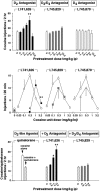Role of dopamine D2-like receptors in cocaine self-administration: studies with D2 receptor mutant mice and novel D2 receptor antagonists
- PMID: 11923462
- PMCID: PMC6758322
- DOI: 10.1523/JNEUROSCI.22-07-02977.2002
Role of dopamine D2-like receptors in cocaine self-administration: studies with D2 receptor mutant mice and novel D2 receptor antagonists
Abstract
Dopamine receptor subtypes have been classified generally as D1-like (e.g., D1, D5) or D2-like (D2, D3, D4), and converging evidence suggests that D2-like receptors may be especially important in mediating the abuse-related effects of cocaine. However, it has been difficult to differentiate the roles of the D2-like receptor subtypes in the behavioral effects of cocaine because of the relatively low selectivity of drugs for D2, D3, and D4 receptors in vivo. The goal of the present series of studies was to investigate the contributions of D2-like receptor subtypes in the reinforcing effects of cocaine using new genetic and pharmacological tools. First, we evaluated cocaine self-administration behavior, and related effects of nonselective D2-like drugs, in mutant mice that lack the D2 receptor but express D3 and D4 receptors. When high doses of cocaine on the descending limb of the cocaine dose-effect function were available, D2 mutant mice self-administered at higher rates than their heterozygous or wild-type littermates, but the ascending limb of the cocaine dose-effect function did not differ between genotypes. Elevated rates of drug intake were not attributable to nonspecific increases in response rate, because response rates maintained by presentation of a range of food concentrations were significantly lower in D2 mutant mice than in wild-type mice. In wild-type mice, pretreatment with the D2-like antagonist eticlopride increased rates of self-administration of high doses of cocaine, and the D2-like agonist quinelorane served as a positive reinforcer when substituted for cocaine. However, these effects of eticlopride and quinelorane were not observed in mice that lacked the D2 receptor. Next, we compared the effects of novel antagonists selective for different D2 receptor subtypes on cocaine self-administration behavior in outbred rats. In rats, a D2 selective antagonist increased rates of self-administration of high doses of cocaine and also combinations of cocaine and the D2-like agonist quinelorane, whereas D3/D4 antagonists were ineffective. Collectively, these findings suggest that the D2 receptor is not necessary for cocaine self-administration, but this receptor subtype is involved in mechanisms that limit rates of high-dose cocaine self-administration. Our results also suggest that D3 and D4 receptors do not play major roles in the modulation of cocaine self-administration by D2-like drugs.
Figures






References
-
- Ahmed SH, Koob GF. Transition from moderate to excessive drug intake: change in hedonic set point. Science. 1998;282:298–300. - PubMed
-
- Baik J-H, Picetti R, Saiardi A, Thirlet G, Dierich A, Depaulls A, Le Meur M, Borrelli E. Parkinsonian-like locomotor impairment in mice lacking dopamine D2 receptors. Nature. 1995;377:424–428. - PubMed
-
- Barr JE, Holmes DB, Ryan LJ, Sharpless SK. Techniques for the chronic cannulation of the jugular vein in mice. Pharmacol Biochem Behav. 1979;11:115–118. - PubMed
-
- Baxter BL, Gluckman MI, Stein L, Scerni RA. Self-injection of apomorphine in the rat: Positive reinforcement by a dopamine receptor stimulant. Pharmacol Biochem Behav 2 1974. 387 391; 1974. - PubMed
Publication types
MeSH terms
Substances
Grants and funding
LinkOut - more resources
Full Text Sources
Other Literature Sources
Medical
Molecular Biology Databases
